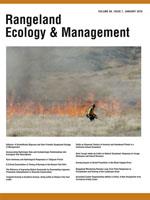Pyric-herbivory is the spatial and temporal interaction of fire and grazing on area resources that results in site selection by animals on recently burned areas. Pyric-herbivory promotes heterogeneity by increasing bare ground on some patches and litter and aboveground biomass on other patches. The influences of this heterogeneity on hydrological properties and sediment transport are not well documented. We monitored the pattern of cattle occupancy on annually burned and patch burned pastures under moderate stocking rates of steers in the Tallgrass Prairie Preserve and quantified surface runoff and sediment transport for simulated rainfall of 10-year return storm intensity applied to different phases of the fire-grazing interaction in 2011 and 2012. Results showed that patch burn altered grazing distribution with cattle spending 70% of their time within the most recently burned areas. Our rainfall simulation results showed the high-intensity grazing following a spring fire did not have a prolonged, ecologically meaningful detrimental impact on hydrological properties of the burned patch in comparison with annually burned grazing pasture. Instead, the increased spatial and temporal heterogeneity of hydraulic properties could potentially enhance resource conservation through runoff and runon interactions within the patch-burned pasture. Further study focusing on quantifying pyric-herbivory effects on runoff and sediment transport at watershed scale will provide needed insights for managing tallgrass prairie for improving ecosystem services.
How to translate text using browser tools
1 January 2016
Pyric-Herbivory and Hydrological Responses in Tallgrass Prairie
Amanda L. West,
Chris B. Zou ,
Elaine Stebler,
Samuel D. Fuhlendorf ,
Brady Allred
ACCESS THE FULL ARTICLE
annual burn grazing
patch bum grazing
rainfall simulation
saturated hydraulic conductivity
sediment transport
surface runoff





